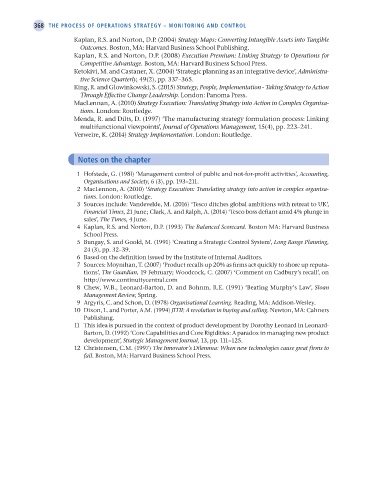Page 393 - Operations Strategy
P. 393
368 The proCess oF operaTIons sTraTegy – monITorIng and ConTrol
Kaplan, R.S. and Norton, D.P. (2004) Strategy Maps: Converting Intangible Assets into Tangible
Outcomes. Boston, MA: Harvard Business School Publishing.
Kaplan, R.S. and Norton, D.P. (2008) Execution Premium: Linking Strategy to Operations for
Competitive Advantage. Boston, MA: Harvard Business School Press.
Ketokivi, M. and Castaner, X. (2004) ‘Strategic planning as an integrative device’, Administra-
tive Science Quarterly, 49(2), pp. 337–365.
King, R. and Glowinkowski, S. (2015) Strategy, People, Implementation - Taking Strategy to Action
Through Effective Change Leadership. London: Panoma Press.
MacLennan, A. (2010) Strategy Execution: Translating Strategy into Action in Complex Organisa-
tions. London: Routledge.
Menda, R. and Dilts, D. (1997) ‘The manufacturing strategy formulation process: Linking
multifunctional viewpoints’, Journal of Operations Management, 15(4), pp. 223–241.
Verweire, K. (2014) Strategy Implementation. London: Routledge.
notes on the chapter
1 Hofstede, G. (198l) ‘Management control of public and not-for-profit activities’, Accounting,
Organisations and Society, 6 (3), pp. 193–211.
2 MacLennon, A. (2010) ‘Strategy Execution: Translating strategy into action in complex organisa-
tions. London: Routledge.
3 Sources include: Vandevelde, M. (2016) ‘Tesco ditches global ambitions with retreat to UK’,
Financial Times, 21 June ; Clark, A. and Ralph, A. (2014) ‘Tesco boss defiant amid 4% plunge in
sales’, The Times, 4 June.
4 Kaplan, R.S. and Norton, D.P. (1993) The Balanced Scorecard. Boston MA: Harvard Business
School Press.
5 Bungay, S. and Goold, M. (1991) ‘Creating a Strategic Control System’, Long Range Planning,
24 (3), pp. 32–39.
6 Based on the definition issued by the Institute of Internal Auditors.
7 Sources: Moynihan, T. (2007) ‘Product recalls up 20% as firms act quickly to shore up reputa-
tions’, The Guardian, 19 February; Woodcock, C. (2007) ‘Comment on Cadbury’s recall’, on
http://www.continuitycentral.com
8 Chew, W.B., Leonard-Barton, D. and Bohnm, R.E. (1991) ‘Beating Murphy’s Law’, Sloan
Management Review, Spring.
9 Argyris, C. and Schon, D. (1978) Organisational Learning. Reading, MA: Addison-Wesley.
10 Dixon, L. and Porter, A.M. (1994) JITII: A revolution in buying and selling. Newton, MA: Cahners
Publishing.
11 This idea is pursued in the context of product development by Dorothy Leonard in Leonard-
Barton, D. (1992) ‘Core Capabilities and Core Rigidities: A paradox in managing new product
development’, Strategic Management Journal, 13, pp. 111–125.
12 Christensen, C.M. (1997) The Innovator’s Dilemma: When new technologies cause great firms to
fail. Boston, MA: Harvard Business School Press.
M10 Operations Strategy 62492.indd 368 02/03/2017 13:28

